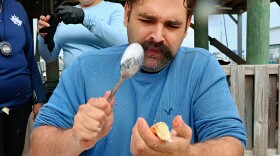Hurricane Fiona left more than three million people without power Sunday in Puerto Rico and conditions could be slow to improve as wind and rain continue Monday.
An island-wide blackout occurred on the island of Puerto Rico Sunday as Hurricane Fiona brought sustained winds of up to 90 miles per hour. The extent of damage is unclear, as heavy rain and flooding continues to wash out roads and bridges early this week. As of publishing, most of the island remains without power, according to utility companies' reports. Governor Pedro Pierluisi stated that the recovery process would be a "matter of days," and not months, unlike the drawn-out power restoration effort following Hurricane Maria in 2017.
The latest advisory from the National Hurricane Center says the center of Hurricane Fiona is moving off the northern coast of the Dominican Republic late Monday morning. Maximum sustained winds within Fiona's center were found to be up to 85 miles per hour as the hurricane tracks toward the northwest at about ten miles per hour. In Puerto Rico, tropical storm conditions are expected to linger through much of Monday, with rain bands forecast to slowly spiral away from the island by Monday evening. Hurricane conditions are expected to last through Monday afternoon in the Dominican Republic before transitioning to tropical storm conditions through Monday night.
Fiona is forecast to strengthen as it moves away from Puerto Rico and the Dominican Republic. The official forecast issued by the NHC suggests Fiona could become a major hurricane by early Wednesday as it moves away from the Turks and Caicos, which will experience hurricane conditions by Tuesday. By Thursday night, Fiona is expected to track near Bermuda before moving quickly into Maritime Canada by the weekend.
Impacts from Hurricane Fiona are expected to remain limited locally, with the main hazard coming in the form of rough seas through much of the week. Aside from rough surf, a life-threatening risk of rip currents will be possible by midweek from the First Coast to the Gold Coast. Advisories and statements for coastal areas may be necessary by midweek as Hurricane Fiona produces northeasterly winds and long period swell. A number of factors could lead to localized coastal flooding through the week, but should remain generally below advisory thresholds.
Copyright 2022 Storm Center.







